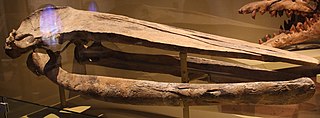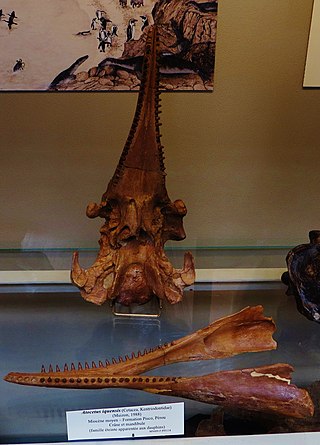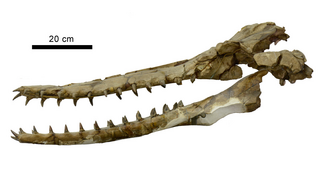
Blainville's beaked whale, or the dense-beaked whale, is believed to be the widest ranging mesoplodont whale. The French zoologist Henri de Blainville first described the species in 1817 from a small piece of jaw — the heaviest bone he had ever come across — which resulted in the name densirostris. Off the northeastern Bahamas, the animals are particularly well documented, and a photo identification project started sometime after 2002.

Orcinus is a genus of Delphinidae, the family of carnivorous marine mammals known as dolphins. It includes the largest delphinid species, Orcinus orca, known as the orca or killer whale. Two extinct species are recognised, Orcinus paleorca and O. citoniensis, describing fossilised remains of the genus. The other extinct species O. meyeri is disputed.

Squalodon is an extinct genus of whales of the Oligocene and Miocene epochs, belonging to the family Squalodontidae. Named by Jean-Pierre Sylvestre de Grateloup in 1840, it was originally believed to be an iguanodontid dinosaur but has since been reclassified. The name Squalodon comes from Squalus, a genus of shark. As a result, its name means "shark tooth". Its closest modern relative is the South Asian river dolphin.
Kentriodon is an extinct genus of toothed whale related to modern-day dolphins. Fossils have been found in North America, Europe and Japan. Several species have been described.

Ontocetus is an extinct genus of walrus, an aquatic carnivoran of the family Odobenidae, endemic to coastal regions of the southern North Sea and the southeastern coastal regions of the U.S. during the Miocene-Pleistocene. It lived from 13.6 mya—300,000 years ago, existing for approximately 13.3 million years.

Parietobalaena is an extinct genus of baleen whale, belonging to the family Pelocetidae. Fossils are found in Miocene-aged marine strata in North America, Europe, Australia, and Japan, including the Temblor and Itahashi formations. Based on previous estimates of juvenile specimens, Tsai (2017) suggested a body size of 12-15 m for P. yamaokai, akin to that of the gray whale.

Aglaocetus is a genus of extinct baleen whales known from the Miocene of Patagonia, the US Eastern Seaboard, Japan and the Low Countries. It was once considered a member of Cetotheriidae along with many other putative cetotheres, but was recently recognized as representing a distinct family from true Cetotheriidae.

Atocetus is an extinct genus of pontoporiid dolphin found in Miocene-age marine deposits in Peru and California.
Zarhinocetus is an extinct genus of whale from the Early to Middle Miocene of the eastern North Pacific.
Allodelphinidae is a family of primitive platanistoid river dolphins found in marine deposits in the eastern North Pacific region, Alaska, and Japan.
Araeodelphis is an extinct genus of river dolphin from the early Miocene of the US Eastern Seaboard.

Lophocetus is an extinct genus of dolphin belonging to the clade Delphinida that is known from late Miocene (Tortonian) marine deposits in California and Maryland. Although usually placed in Kentriodontidae, recent studies have found it only distantly related to Kentriodon.
Squaloziphius is an extinct genus of odontocete cetacean from the Early Miocene (Aquitanian) aged marine deposits in Washington state.
Xenorophus is a genus of primitive odontocete from late Oligocene (Chattian) marine deposits in South Carolina belonging to Xenorophidae.

Phoberodon is a genus of archaic odontocete cetacean from the Early Miocene (Burdigalian) of Patagonia, Argentina.

Brachydelphis is a genus of pontoporiid known from the Late Miocene Pisco Formation of Peru and the Bahía Inglesa Formation of Chile.
Chilcacetus is an extinct genus of primitive odontocete known from Early Miocene (Aquitanian) of Peru. Fossils were found in and named after the Chilcatay Formation of the Pisco Basin.
Eudelphis is an extinct genus of sperm whale belonging to Physeteroidea that lived in the ancient North Sea basin about 16-11 million years ago, during the middle Miocene (Langhian).
Archaeodelphis is an extinct genus of primitive odontocete cetacean from late Oligocene (Chattian) marine deposits in South Carolina, and belonging to the family Xenorophidae.
Inticetus is an extinct genus of Early Miocene odontocete from the Chilcatay Formation, Pisco Basin, Peru.










